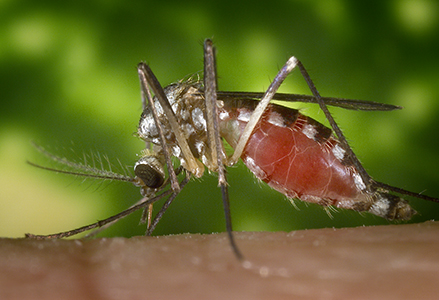
Gene Edited Catastrophe in Brazil
By F. William Engdahl
2 October 2019
Image credits: CDC/ James Gathany - Ochlerotatus triseriatus, also known as Aedes triseriatus, identified in mosquito pools, which had been designated as positive for the West Nile Virus, and is also a known vector for the La Crosse virus. https://phil.cdc.gov/Details.aspx?pid=2166
A British-American gene-editing company has released millions of genetically modified mosquitoes containing a dominant lethal gene, each week for 27 months in the Bahia, Brazil region in a test to see if the gene-edited mosquitoes would mate with local mosquitoes carrying Zika, malaria or other mosquito-borne diseases. A new study documents the alarming fact that following an initial reduction of the target population of mosquitoes, after some months the “population which had been greatly suppressed rebounded to nearly pre-release levels.” Scientists to date have no idea what dangers are presented by the new mutations. This once more highlights the dangers of uncontrolled gene-editing of species
.
According to a new published study in Nature Reports journal, genetically engineered mosquitoes produced by the biotech company, Oxitec, now part of the US company Intrexon, have escaped human control after trials in Brazil and are now spreading in the environment.
On paper the theory was brilliant. Strains of “yellow fever” male mosquitoes taken from Cuba and Mexico were altered using gene-editing to make it impossible for their offspring to survive. Oxitec then began a systematic release of tens of millions of the manipulated mosquitoes over more than two years in the the city of Jacobina in the region of Bahia in Brazil. The Oxitec theory was the altered mosquitoes would mate with normal females of the same type which carry infectious diseases like dengue fever, and kill them off in the process.
‘Unanticipated Outcome…’
A team of scientists from Yale University and several scientific institutes in Brazil monitored the progress of the experiment. What they found is alarming in the extreme. After an initial period in which the target mosquito population markedly declined, after about 18 months the mosquito population recovered to pre-release levels. Not only that, the paper notes that some of the mosquitos likely have “hybrid vigor,” in which a hybrid of the natural with the gene-edited has created “a more robust population than the pre-release population” which may be more resistant to insecticides, in short, resistant “super mosquitoes.”
The scientists note that, “Genetic sampling from the target population six, 12, and 27–30 months after releases commenced provides clear evidence that portions of the transgenic strain genome have been incorporated into the target population. Evidently, rare viable hybrid offspring between the release strain and the Jacobina population are sufficiently robust to be able to reproduce in nature…” They continue, “Thus, Jacobina Ae. aegypti are now a mix of three populations. It is unclear how this may affect disease transmission or affect other efforts to control these dangerous vectors.” They estimate that between 10% and 60% of the Bahia natural Ae. Aegypti mosquitoes now had some gene-edited OX513A genome. They conclude that “The three populations forming the tri-hybrid population now in Jacobina (Cuba/Mexico/Brazil) are genetically quite distinct, very likely resulting in a more robust population than the pre-release population due to hybrid vigor.”
This was not supposed to happen. Professor of ecology and evolutionary biology, Jeffrey Powell, senior author of the study, remarked on the findings: “The claim was that genes from the release strain would not get into the general population because offspring would die. That obviously was not what happened.” Powell went on to note, “But it is the unanticipated outcome that is concerning.”
A Gates Foundation Project
The Brazil study deals a major alarm signal on the uncontrolled release of gene-edited species into nature. It calls to mind the horror plot of Michael Crichton’s 1969 science fiction novel, Andromeda Strain. Only it is no novel.
The Oxitec mosquitoes were developed using a highly controversial form of gene-editing known as gene drive. Gene Drive, which is also being heavily funded by the Pentagon’s DARPA, combined with CRISPR gene-editing, aims to force a genetic modification to spread through an entire population, whether of mosquitoes or potentially humans, in just a few generations.
The scientist who first suggested developing gene drives in gene-editing, Harvard biologist Kevin Esvelt, has publicly warned that development of gene editing in conjunction with gene drive technologies has alarming potential to go awry. He notes how often CRISPR messes up and the likelihood of protective mutations arising, making even benign gene drives aggressive. He stresses, “Just a few engineered organisms could irrevocably alter an ecosystem.” Esvelt’s computer gene drive simulations calculated that a resulting edited gene “can spread to 99 percent of a population in as few as 10 generations, and persist for more than 200 generations.” This is very much what has now been demonstrated in the mosquito experiment in Brazil.
Notable is the fact that the Oxitec Brazil mosquito experiment was funded by the Bill & Melinda Gates Foundation. In June, 2018 Oxitec announced a joint venture with the Gates Foundation, “to develop a new strain of Oxitec’s self-limiting Friendly™ Mosquitoes to combat a mosquito species that spreads malaria in the Western Hemisphere.” The Brazil results show the experiment is a catastrophic failure as the new strain is anything but self-limiting.
The Gates Foundation and Bill Gates have been backing development of the radical gene-editing technology and gene drive technology for more than a decade. Gates, a long-time advocate of eugenics, population control and of GMO, is a strong gene-editing promoter. In an article in the May/June 2018 magazine of the New York Council on Foreign Relations, Foreign Affairs, Gates hails gene editing technologies, explicitly CRISPR. In the article Gates argues that CRISPR and other gene-editing techniques should be used globally to meet growing demand for food and to improve disease prevention, particularly for malaria. In his article he adds, “there is reason to be optimistic that creating gene drives in malaria-spreading mosquitoes will not do much, if any, harm to the environment.”
Every bit as alarming as the failure of the Brazil gene-editing mosquito experiment is the fact that this technology is being spread with virtually no prior health or safety testing by truly independent government institutions. To date the US Government relies only on industry safety assurances. The EU, while formally responsible to treat gene-edited species similarly to GMO plants, is reportedly trying to loosen the regulations. China, a major research center for gene-editing, has extremely lax controls. Recently a Chinese scientist announced an experiment in human gene-editing allegedly to make newborn twins resistant to HIV. Other experiments are proliferating around the world with gene-edited animals and even salmon. The precautionary principle has been thrown to the winds when it comes to the new gene-editing revolution, not a reassuring situation.
Currently Oxitec, which denies that the Brazil results show failure, is now trying to get regulatory approval from the US Environmental Protection Agency to conduct a similar experiment with the same gene-edited species in Texas and Florida. One of the people involved in the attempt, Texan Roy Bailey, is a Washington lobbyist and close friend of Randal Kirk, the billionaire CEO of Intrexon, owner of Oxitec. Bailey is also a major Trump fundraiser. Let’s hope that regulatory prudence and not politics decide the outcome.
F. William Engdahl is strategic risk consultant and lecturer, he holds a degree in politics from Princeton University and is a best-selling author on oil and geopolitics, exclusively for the online magazine “New Eastern Outlook”
